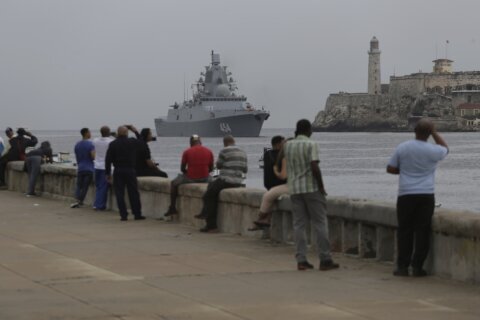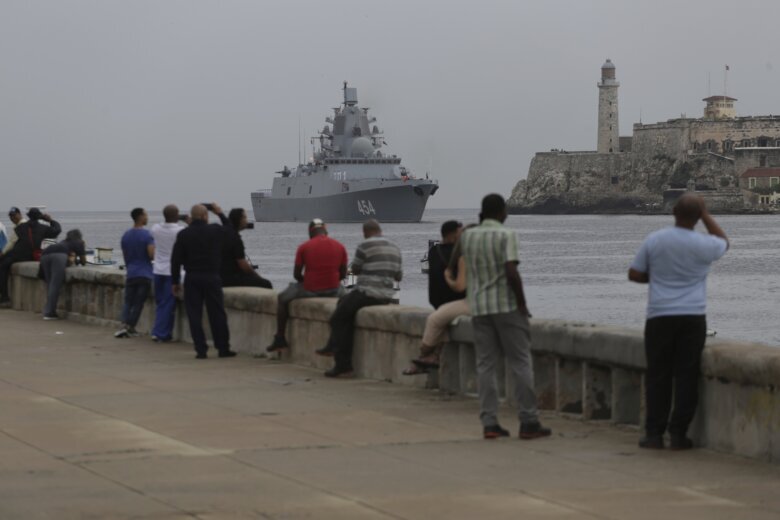
Days after Russian and Chinese bombers teamed up for an unprecedented joint patrol near Alaskan airspace, a flotilla of Russian warships arrived in Cuba, for the second time in two months.
The intended shows of force, according to a United States intelligence expert, are part of an effort by the Kremlin to use its recently formalized partnership with Beijing and its Cold War-era alliance with Havana to try to “embarrass” Washington and assess the U.S. military.
“It’s a way to test the other side’s response time,” said Chris Simmons, a retired counterintelligence officer with the Defense Intelligence Agency about the Alaska operation. “To the best of my knowledge … we’ve never seen them do this jointly with the Chinese.”
Simmons — who helped expose Ana Montes, an American who spied for Cuba while working for the U.S. government for more than a decade — said the Alaska event and its aftermath bear watching, “because after all these decades, they’ve developed a new way to work together, and the intent is to provoke the U.S.”
The objective of the joint Alaska flight, he said, was to trigger the launch of American and Canadian fighter jets deployed by the North American Aerospace Defense Command (NORAD) and force them to expend time, fuel and wear and tear on their aircrafts intercepting Russian and Chinese planes.
Simmons also believes the incident was designed to help Russia and China flex their perceived “superpower” statuses.
“I think part of (the Alaska patrol) is to discredit the White House, because it’s one of those (situations) where it makes headlines, and there’s absolutely nothing you can do, as long as they turn before they hit the intercept zone,” said Simmons.
When asked about the incident, U.S. Secretary of Defense Lloyd Austin said, “I won’t discuss any intelligence issues here at the podium, but it’s the first time that we’ve seen these two countries fly together like that.”
He said, however, the flight “was not a surprise to us. We closely monitored these aircraft, tracked and intercepted the aircraft.”
NORAD said in a statement that “two Russian TU-95 and two PRC H-6 military aircraft were operating in the Alaska Air Defense Identification Zone (ADIZ),” when fighter jets from the U.S. and Canada conducted the intercept.
Austin pointed out that the attempted incursion was turned away well before the planes entered U.S. airspace, but the relationship between these two countries is driving deep concern.
“I think the closest point of approach was about 200 miles off our coast. This is a thing that we track very closely. We were able to intercept and it, and if it happens again, if there’s any kind of a challenge from any direction, I have every confidence NORTHCOM and NORAD will be at the ready and we will be able to intercept,” Austin said.
Russian provocations increasing
When Russian ships arrived on June 12, Cubans lined the waterfront in Havana to take pictures. As four Russian naval vessels slowly moved into the harbor, sailors aboard one of the vessels stood in military formation. It was an unmistakable gesture that Moscow’s repeated around the world.
“This is very definitely a message from Vladimir Putin,” said Kurt Volker, former U.S. ambassador to NATO.
Less than a week later, Putin landed in Pyongyang for the signing of a historic deal with North Korean dictator Kim Jong Un. The meeting between the two, the second in less than a year, fueled worry that the renewing of their Cold War military relationship could lead to a profound, mutually useful weapons and technology partnership.
Currently a distinguished fellow at the Center for European Policy Analysis, Volker said Moscow was taunting the U.S. and issuing a warning to stop supporting Ukraine or “maybe Russia will do something to harm our security as well.”
Volker said the message is, “Look, they can show up here 90 miles from the U.S. border with a nuclear submarine. We better be careful. That’s the kind of threat that Vladimir Putin likes to make.”
U.S. military officials have watched Russia’s activity in the Western Hemisphere very carefully.
“We’re constantly monitoring, whether it be Russia or any foreign vessel operating near U.S. territorial waters. We’re always going to monitor the activities of those foreign countries,” said Deputy Pentagon Press Secretary Sabrina Singh.
“The Navy’s U.S. second fleet, U.S. fourth fleet, U.S. Coast Guard, Atlantic area and the Canadian Joint Task Force Atlantic are conducting routine operations throughout the Atlantic,” said Singh.
The second wave of Russian ships deployed to Havana arrived July 27. They included, according to Russian state media RIA Novosti, the training ship Smolny, the patrol frigate Neustrashimy (Fearless) and the refueling tanker Yelnya.
During the visit, Cuban citizens reportedly were allowed to board and tour the Smolny.
Cuba’s proximity has always been a security concern for the U.S. because adversaries can use it as a listening post. But another growing worry is that both China and Russia are developing increasingly robust intelligence collections capabilities inside Cuba.
“They both need Cuba as a base to do signals collection, because they’re the only nation in this hemisphere, in the footprint of U.S. satellites,” said Simmons.
From positions inside Cuba, Russian and Chinese intelligence operatives, using their sophisticated technology, “can collect everything (that’s unencrypted) from Northern Canada to the tip of Argentina,” according to Simmons.
But, he points out, “they’re best at the United States,” because it’s their No. 1 target.
Get breaking news and daily headlines delivered to your email inbox by signing up here.
© 2024 WTOP. All Rights Reserved. This website is not intended for users located within the European Economic Area.









